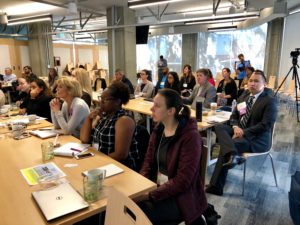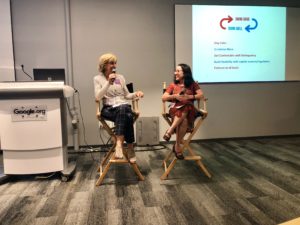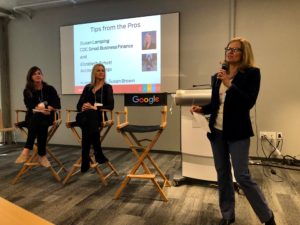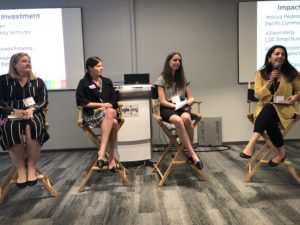 On April 23, 2019, more than 60 microlenders and other lending stakeholders gathered for one of our favorite events – the MicroLenders Forum – at the Google Foundation.
On April 23, 2019, more than 60 microlenders and other lending stakeholders gathered for one of our favorite events – the MicroLenders Forum – at the Google Foundation.
We kicked off the day with a listening session. Steve de Jesus from the FDIC promoted an organizing roundtable (in English) on May 22 in San Jose for a Spanish-speaking training they are offering across the state. Angel Cardozo, the executive director of the San Francisco SBDC, explained how the SBDC network wants to be a great partner for funders and send a borrower to a person, not a system. The NorCal SBDC Finance Center makes the loan process easier for both the lender and the borrower. They help local businesses be better prepared for loan applications and package their financials. Their experienced lending advisors will help business owners structure their business loan request and match up with the right lender. They also help them prepare their projections with assumptions and create a business/expansion plan to meet the lenders’ needs. Other ideas that popped up and that members are thinking about include:
- Keeping pace with technology and how to scale
- Impact investment for rural communities in Opportunity Zones
- Prospera has seed funding for lending
- How to balance harnessing technology as a tool and staying true to the mission
- Collective impact reporting is a problem
 Lucas Puente, the lead economist for Thumbtack, gave an engaging presentation on the economy. Don’t panic – we’re not heading into a recession in 2019 – most likely. He talked about the reasons for his optimism as well as structural issues, such as a decline in economic mobility, that will affect the economy in the long run. And the big elephant in the room is that politics has the ability to produce short term economic shocks. Kim Buttemer, COO of CDC Small Business Finance, gave advice about how to react in the face of economic distress. First, recognize some signs and start to plan when payment delays start happening. Second, her big ‘aha’ moment was to recognize that her CDFI was an economic development organization and not a bank – and that pushed CDC to work with clients differently. Third, they were patient; they were flexible on repayment schedules and loan deferments and the result is 300 businesses kept their doors open. Fourth, be honest with your funders and investors. And finally, don’t panic!
Lucas Puente, the lead economist for Thumbtack, gave an engaging presentation on the economy. Don’t panic – we’re not heading into a recession in 2019 – most likely. He talked about the reasons for his optimism as well as structural issues, such as a decline in economic mobility, that will affect the economy in the long run. And the big elephant in the room is that politics has the ability to produce short term economic shocks. Kim Buttemer, COO of CDC Small Business Finance, gave advice about how to react in the face of economic distress. First, recognize some signs and start to plan when payment delays start happening. Second, her big ‘aha’ moment was to recognize that her CDFI was an economic development organization and not a bank – and that pushed CDC to work with clients differently. Third, they were patient; they were flexible on repayment schedules and loan deferments and the result is 300 businesses kept their doors open. Fourth, be honest with your funders and investors. And finally, don’t panic!
After lunch, we had tips from the pros by Elizabeth Schott, CEO of Accion San Diego, and Susan Lamping, Vice President of Sales at CDC Small Business Finance. For beginners they offer this advice:
- Understand your target market
- Understand the risk involved in lending to that market
- Establish systems – CRM, portfolio management, accounting, and data collection
- Understand the lifecycle of a client
- Establish written guidelines and periodically review
- Track and assess deal flow
- Stay on top of mind of borrowers
 And tips for growth:
And tips for growth:
- Create a culture
- Pay attention to remote staff – have a good system
- Understand there will be more staff turnover
- Get technology efficiencies where you can, e.g. use Hubspot to automate communication with potential leads
- Create dashboards and goals both departmental and organization-wide and share
- Be aware of scaling choice between specializing processes or more people doing the process from start to finish
- Be aware of the growth strategy to grow slow and organically with existing staff or over-hire, then find clients
- Assess, revise, and do it again
In the afternoon, we had two great panels that have the potential to provide new funding sources for CDFIs and/or their clients – impact investment and opportunity zones. These subjects deserve much more attention than I’m able to give at this point, but what follows is a summary of our discussion at the forum. CAMEO will continue to monitor these trends and keep you all informed!
 Impact investment is investment with a financial and social return. It’s a relatively new field in its current form that is starting to create a common language based on the UN’s 17 Sustainable Development Goals. Investors conduct financial due diligence because that’s what you do when you make an investment. When you make an impact investment, you need to figure out how to measure the impact. Jesse Pederson from Pacific Community Ventures talked about PCV’s tool to help do due diligence on social and environmental impacts of an investment. Alison Kelly of CDC Small Business Finance explained that an impact score can make underwriting more consistent across investments and help with portfolio management. Mindy Christensen of Amalgamated Bank offered advice for CDFIs that want to get started with impact investment: build relationships with funders and be honest; be able to address investor concerns on how money will be deployed with a plan; make the ‘ask’ broad; and communicate, report, communicate, and report (and do it again).
Impact investment is investment with a financial and social return. It’s a relatively new field in its current form that is starting to create a common language based on the UN’s 17 Sustainable Development Goals. Investors conduct financial due diligence because that’s what you do when you make an investment. When you make an impact investment, you need to figure out how to measure the impact. Jesse Pederson from Pacific Community Ventures talked about PCV’s tool to help do due diligence on social and environmental impacts of an investment. Alison Kelly of CDC Small Business Finance explained that an impact score can make underwriting more consistent across investments and help with portfolio management. Mindy Christensen of Amalgamated Bank offered advice for CDFIs that want to get started with impact investment: build relationships with funders and be honest; be able to address investor concerns on how money will be deployed with a plan; make the ‘ask’ broad; and communicate, report, communicate, and report (and do it again).
Everyone’s been hearing about opportunity zones (OZ) – which are census tracks designated for investment. The investment comes because of a tax incentive. Investors can defer or eliminate capital gains. In California, this is of special interest because there is a lot of wealth being generated by IPOs; nationally six trillion dollars are sitting in capital gains. In order to deploy the wealth in low-income communities, there was a bipartisan tax incentive created to encourage investment. Ian Ross from OppSites.com explained the phenomenon and what is actually happening in the Opportunity Zones world. Marisa Raya from the City of Oakland serves as a communication link between investors and people on the ground. She explained how Oakland is trying to ensure that the relationships between OZs and redlined tracts don’t share the same fate. The city is trying to put some transparency and reporting requirements for OZs. Kevin Stein from California Reinvestment Coalition talked about the potential dangers of displacement and the work that they are doing to prevent that from happening. This could be a great opportunity, but many are not hopeful.
The Opportunity Zones program has the potential to encourage new investments in eligible communities that improve the lives of residents with low incomes. However, the vast majority of the tax benefits will be realized by wealthy investors, and the program may accelerate gentrification in some areas or subsidize investments that offer little or no benefit to community residents.
